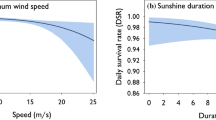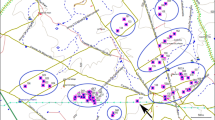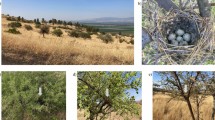Abstract
The timing of breeding in birds has important consequences if food availability varies seasonally. Optimal timing of the most energetically demanding stages of breeding to coincide with peaks in food availability can increase breeding success. Early breeding may be challenging for females producing eggs, but generally birds initiating egg-laying early in the breeding season are more likely to succeed. Initiating egg-laying later may be less costly to females, but raising offspring after the peak in food availability becomes challenging. Balancing these costs and benefits is important for the cooperative breeding Southern Ground-hornbill Bucorvus leadbeateri (hereafter ‘Ground-hornbill’), which typically produces only a single clutch of two eggs and fledges a single chick per breeding season. A previous study found that Ground-hornbill groups that lay early in the breeding season are more likely to fledge a chick than later-breeding groups. We investigated factors associated with the timing of breeding such as group size, the type of nest used, rainfall and temperature in a study site supplemented with nest boxes. Ground-hornbills laid eggs from 9 September to 14 November and the average number of days between the first and the last laying date in a season was 48 ± 32 days (range 10–101 days). Larger groups, particularly those using natural nests compared to those using nest boxes, laid later than smaller groups. Egg-laying was delayed under hot, dry spring conditions and laying dates were earlier following above-average spring rainfall.
Zusammenfassung
Die Einflüsse von Wetter, Gruppengröße und Nesttyp auf den Zeitpunkt der Eiablage beim Kaffernhornraben Bucorvus leadbeateri
Wann Vögel brüten, ist wichtig, wenn die Nahrungsverfügbarkeit im Verlauf der Brutsaison schwankt. Die energieaufwendigsten Brutstadien mit der höchsten Nahrungsverfügbarkeit zu synchronisieren, kann den Bruterfolg erhöhen. Eine frühe Brut kann für die eierlegenden Weibchen eine Herausforderung bedeuten, doch generell sind Vögel, die früh in der Saison mit der Eiablage beginnen, mit höherer Wahrscheinlichkeit erfolgreich. Ein späterer Legebeginn kann für die Weibchen mit geringeren Kosten verbunden sein, aber die Küken erst aufzuziehen, wenn die Nahrungsverfügbarkeit bereits abnimmt, ist schwierig. Die richtige Kosten-Nutzen Balance zu finden, ist wichtig für den kooperativ brütenden Kaffernhornraben Bucorvus leadbeateri, welcher pro Brutsaison normalerweise nur ein einziges aus zwei Eiern bestehendes Gelege und ein flügges Küken produziert. Eine vorherige Studie fand, dass früh in der Brutsaison legende Kaffernhornraben-Gruppen mit höherer Wahrscheinlichkeit ein flügges Küken produzierten als später legende Gruppen. Wir haben mit dem Brutzeitpunkt assoziierte Faktoren wie Gruppengröße, Nesttyp, Regen und Temperatur in einem mit Nistkästen ausgestatteten Studiengebiet untersucht. Kaffernhornraben legten vom 9. September bis zum 14. November, und der durchschnittliche Unterschied zwischen erstem und letztem Legedatum betrug 48 ± 32 Tage (Variationsbreite 10-101 Tage). Größere Gruppen legten später als kleinere, besonders wenn sie in natürlichen Nisthöhlen und nicht in den Nistkästen brüteten. Die Eiablage war bei heißem, trockenem Frühlingswetter verzögert und erfolgte früher nach überdurchschnittlichen Frühlingsregenfällen.

Similar content being viewed by others
References
Bates D, Maechler M, Bolker B, Walker S (2015) Fitting linear mixed-effects models using lme4. J Stats Softw 67:1–48
Both C, Artemyev AV, Blaauw B, Cowie RJ, Dekhuijzen AJ, Eeva T, Enema A, Gustafsson L, Ivankina EV, Järvinen A, Metcalfe NB, Nyholm NEI, Potti J, Ravussin P-A, Sanzi JJ, Silverin B, Slater FM, Sokolov LV, Török J, Winkel W, Wright J, Zang H, Visser ME (2004) Large-scale geographical variation confirms that climate change causes birds to lay earlier. Proc R Soc Lond B 271:1657–1662
Brazill-Boast J, Pryke SR, Griffith SC (2013) Provisioning habitat with custom-designed nest boxes increases reproductive success in an endangered finch. Aust Ecol 38:405–412
Brown L, Brown C (1984) Is food supply the main determinant of African bird breeding seasons? Proc Pan-Afr Ornithol Congr 5:753–761
Carstens KF, Kassanjee R, Little RM, Ryan PG, Hockey PAR (2019) Breeding success and population growth of Southern Ground Hornbills Bucorvus leadbeateri in an area supplemented with nest boxes. Bird Cons Int
Chambers LE, Altwegg R, Barbraud C, Barnard P, Beaumon LJ, Crawford RJM, Durant JM, Hughes L, Keatley MR, Low M, Morellato PC, Poloczanska ES, Ruoppolo V, Vanstreels RET, Woehler EJ, Wolfaardt AC (2013) Phenological changes in the southern hemisphere. PLOS ONE 8:e75514
Core Team R (2014) R: a language and environment for statistical computing. R Foundation for Statistical Computing, Vienna
Cunningham S, Madden C, Barnard P, Amar A (2016) Electric crows: powerlines, climate change and the emergence of a native invader. Div Distr 22:17–29
Daan S, Dijkstra C, Drent R, Meijer T (1989) Food supply and the annual timing of avian reproduction In: Ouellet H (eds) Proceedings of the 19th International Ornithogical Congress, University of Ottawa Press, Ottawa, pp 392 407
Denlinger DL (1980) Seasonal and annual variation of insect abundance in the Nairobi National Park, Kenya. Biotropica 12:100–106
Doerr E, Doerr VJ (2007) Positive effects of helpers on reproductive success in the Brown Treecreeper and the general importance of future benefits. J Ani Ecol 76:966–976
Dunn P (2004) Breeding dates and reproductive performance. In: Møller AP, Fiedler W, Berthold P (eds) Birds and climate change. Elsevier, San Diego, pp 67–85
Dunn P, Winkler D (2010) Effects of climate change on timing of breeding and reproductive success in birds. In: Møller AP, Fielder W, Berthold P (eds) Effects of climate change on birds. Oxford University Press, Oxford, pp 113–128
Eeva T, Veistola S, Lehikoinen E (2000) Timing of breeding in subarctic passerines in relation to food availability. Can J Zool 78:67–78
Fox J, Weisberg S (2011) An R companion to applied regression, 2nd edn. Sage, Thousand Oaks
Goutte A, Antoine E, Weimerskirch H, Chastel O (2010) Age and the timing of breeding in a long-lived bird: a role for stress hormones? Funct Ecol 24:1007–1016
Grieco F, van Noordwijk AJ, Visser ME (2002) Evidence for the effect of learning on timing of reproduction in Blue Tits. Sci 296(5565):136–138
Hau M (2001) Timing of breeding in variable environments: tropical birds as model systems. Horm Behav 40:281–290
Heinsohn RG (1992) Cooperative enhancement of reproductive success in White-winged Choughs. Evol Ecol 6:97–114
Kemp AC (1976) Environmental factors affecting the onset of breeding in some southern African hornbills, Tockus spp. J Reprod Fertil 19:319–331
Kemp AC (2005) Southern Ground Hornbill. In: Hockey PAR, Dean WAJ, Ryan PG (eds) Roberts birds of Southern Africa, 7th edn. John Voelcker Bird Book Fund, Cape Town, pp 158–159
Kemp AC (1990) The behavioural ecology of the Southern Ground Hornbill: are competitive offspring at a premium? In: Proceeding of the 100th Meeting of the German Ornithologists’ Society, Bonn, pp 267–271
Kemp AC, Kemp MI (1980) The biology of the Southern Ground Hornbill Bucorvus leadbeateri (Vigors) (Aves: Bucerotidae). Ann Transvaal Mus 32:65–100
Kemp AC, Kemp MI (1991) Timing of egg-laying by Southern Ground Hornbills Bucorvus leadbeateri in the central Kruger National Park. Ostrich 62:80–82
Koenig WD, Mumme RL (1987) Population ecology of the cooperatively breeding Acorn Woodpecker. Princeton University Press, Princeton, p 460
Little RM, Crowe TM (1993) The breeding biology of the Greywing Francolin Francolinus africanus and its implications for hunting and management. S Afr J Zool 28:6–12
Lloyd P (1999) Rainfall as a breeding stimulus and clutch size determinant in South African arid-zone birds. Ibis 141:637–643
Low M, Arlt D, Pärt T, Öberg M (2015) Delayed timing of breeding as a cost of reproduction. J Av Bio 46:325–331
Mares R, Doutrelant C, Paquet M, Spottiswoode CN, Covas R (2017) Breeding decisions and output are correlated with both temperature and rainfall in an arid-region passerine, the Sociable Weaver. R Soc Open Sci 4(9):e170835
McCleery RH, Perrins CM, Sheldon BC, Charmantier A (2008) Age-specific reproduction in a long-lived species: the combined effects of senescence and individual quality. Proc R Soc Lon B 275:963–970
Møller AP, Fiedler W, Berthold P (eds) (2010) Effects of climate change on birds. Oxford University Press, Oxford, p 332
Moreau RE (1950) The breeding seasons of African birds. 1. Land birds. Ibis 92:223–267
Nakagawa S, Schielzeth H (2013) A general and simple method for obtaining R 2 from generalized linear mixed-effects models. Methods Ecol Evol 4:133–142
Perrins CM (1970) The timing of birds’ breeding seasons. Ibis 112:242–255
Perrins CM (1991) Tits and their caterpillar food supply. Ibis 133:49–54
Poulin B, Lefebvre G, McNeil R (1992) Tropical avian phenology in relation to abundance and exploitation of food resources. Ecology 73:2295–2309
Saunders DA (1982) The breeding behaviour and biology of the short-billed form of the White-tailed Black Cockatoo Calyptorhynchus funereus. Ibis 124:422–455
Saunders DA, Wintle BA, Mawson PR, Dawson R (2013) Egg-laying and rainfall synchrony in an endangered bird species: implications for conservation in a changing climate. Biol Cons 161:1–9
Saunders DA, Dawson R, Nicholls A (2016) Breeding failure and nestling body mass as a function of age of breeding females in the endangered Carnaby’s Cockatoo, Calyptorhynchus latirostris. Aust Zool 38:171–182
Sinclair ARE (1978) Factors affecting the food supply and breeding season of resident birds and movements of Palaearctic migrants in a tropical African savannah. Ibis 120:480–497
Svensson E (1995) Avian reproductive timing: when should parents be prudent? Anim Behav 49:1569–1575
Sydeman WJ, Penniman JF, Penniman TM, Pyle P, Ainley DG (1991) Breeding performance in the Western Gull: effects of parental age, timing of breeding and year in relation to food availability. J Anim Ecol 60:135–149
Taylor MR, Kemp LV (2015) Southern Ground Hornbill. In: Taylor MR, Peacock F, Wanless RM (eds) The 2015 Eskom red data book of birds of South Africa, Lesotho and Swaziland. BirdLife South Africa, Johannesburg, pp 119–121
Thomson AL (1950) Factors determining the breeding seasons of birds: an introductory review. Ibis 92:173–184
Trivedi AK, Rani S, Kumar V (2006) Control of annual reproductive cycle in the subtropical House Sparrow (Passer domesticus): evidence for conservation of photoperiodic control mechanisms in birds. Front Zool 3:12
Turner AK (1982) Timing of laying by Barn Swallows (Hirundo rustica) and Sand Martins (Riparia riparia). J Anim Ecol 51:29–46
van der Waal C (2010) Nutrients in an African savanna: the consequences of supply heterogeneity for plants and animals. Dissertation, University of Wageningen
Verhulst S, Nilsson J-Å (2008) The timing of birds’ breeding seasons: a review of experiments that manipulated timing of breeding. Phils Trans R Soc Lon B 363:399–410
Visser ME, Holleman LJM, Caro SP (2009) Temperature has a causal effect on avian timing of reproduction. Proc R Soc Lon B 276:2323–2331
Wald A (1947) Sequential analysis. Wiley, New York, p 232
Watson DM, Anderson SE, Olson V (2015) Reassessing breeding investment in birds: class-wide analysis of clutch volume reveals a single outlying family. PLOS ONE 10:e0117678
Wikelski M, Hau M, Wingfield JC (2000) Seasonality of reproduction in a Neotropical rain forest bird. Ecology 81:2458–2472
Williams DA, Rabenold KN (2005) Male-biased dispersal, female philopatry, and routes to fitness in a social corvid. J Anim Ecol 74:150–159
Wilson G, Hockey PAR (2013) Causes of variable reproductive performance by Southern Ground Hornbill Bucorvus leadbeateri and implications for management. Ibis 155:476–484
Woxvold IA, Magrath ML (2005) Hel** enhances multiple components of reproductive success in the cooperatively breeding Apostlebird. J Anim Ecol 74:1039–1050
Wyness W (2011) Home range use by Southern Ground Hornbills (Bucorvus leadbeateri)—quantifying seasonal habitat selection and vegetation characteristics. Dissertation, University of Cape Town
Zann R, Morton S, Jones K, Burley N (1995) The timing of breeding by Zebra Finches in relation to rainfall in Central Australia. Emu 95:208–222
Zuur AF, Ieno EN (2016) A protocol for conducting and presenting results of regression-type analyses. Meth Ecol Evol 7:636–645
Acknowledgements
We thank the landowners and wardens of the Associated Private Nature Reserves for access to properties, and assistance with fieldwork. This research was funded by the Technology and Human Resources for Industry Programme of the Department of Trade and Industry; Dow Southern Africa; the Hans Hoheisen Charitable Trust; and Senelala Estates.
Author information
Authors and Affiliations
Corresponding author
Ethics declarations
Ethical approval
All fieldwork was carried out in accordance with the ethical standards of the University of Cape Town (ethics protocol 2016/v2/PR).
Additional information
Communicated by C. Barbraud.
Publisher's Note
Springer Nature remains neutral with regard to jurisdictional claims in published maps and institutional affiliations.
Phillip A. R. Hockey: Deceased.
Rights and permissions
About this article
Cite this article
Carstens, K.F., Kassanjee, R., Little, R.M. et al. The effects of weather, group size and type of nest on the timing of egg-laying in the Southern Ground-hornbill Bucorvus leadbeateri. J Ornithol 160, 633–640 (2019). https://doi.org/10.1007/s10336-019-01654-x
Received:
Revised:
Accepted:
Published:
Issue Date:
DOI: https://doi.org/10.1007/s10336-019-01654-x




